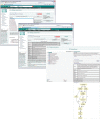The Ontology Lookup Service: more data and better tools for controlled vocabulary queries
- PMID: 18467421
- PMCID: PMC2447739
- DOI: 10.1093/nar/gkn252
The Ontology Lookup Service: more data and better tools for controlled vocabulary queries
Abstract
The Ontology Lookup Service (OLS) (http://www.ebi.ac.uk/ols) provides interactive and programmatic interfaces to query, browse and navigate an ever increasing number of biomedical ontologies and controlled vocabularies. The volume of data available for querying has more than quadrupled since it went into production and OLS functionality has been integrated into several high-usage databases and data entry tools. Improvements have been made to both OLS query interfaces, based on user feedback and requirements, to improve usability and service interoperability and provide novel ways to perform queries.
Figures




